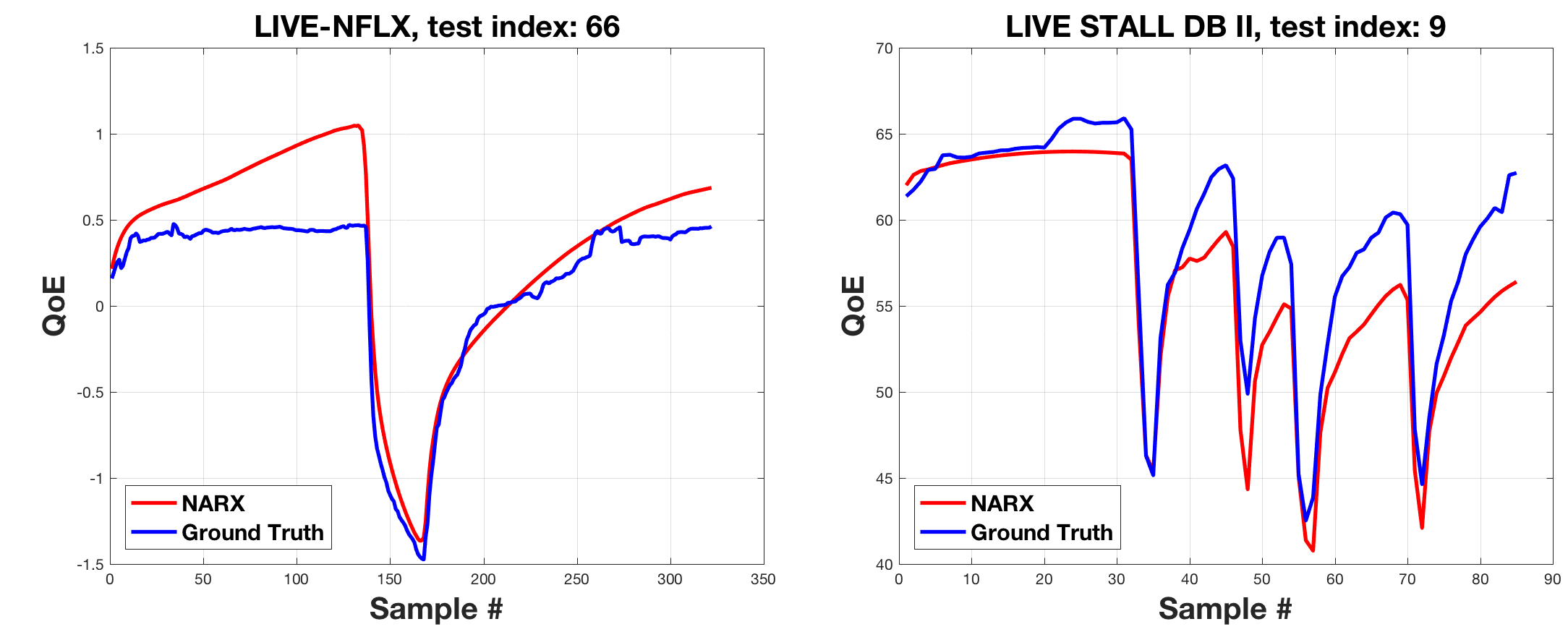NARX-QoE: Continuous Prediction of Streaming Video QoE using Dynamic Networks
NARX-QoE model
Introduction
Streaming video data accounts for a large portion of mobile network traffic. Given the throughput and buffer limitations that currently affect mobile streaming, compression artifacts and rebuffering events commonly occur. Being able to predict the effects of these impairments on perceived video Quality of Experience (QoE) could lead to improved resource allocation strategies enabling the delivery of higher quality video. Towards this goal, we propose a first of a kind continuous Quality of Experience prediction engine. Prediction is based on a non-linear autoregressive model with exogenous outputs. Our QoE prediction model is driven by three QoE-aware inputs: an objective measure of perceptual video quality, rebuffering-aware information and a QoE memory descriptor that accounts for recency. We evaluate our method on recent QoE datasets containing continuous time subjective scores.
Here is an example of the predictive performance of NARX-QoE. On the left, the performance of the proposed NARX-QoE on the LIVE Netflix Video Quality of Experience Database is shown. On the right, the performance of the proposed NARX-QoE on the LIVE Stall Database II is shown.
Download
The NARX-QoE software is available to the research community free of charge. If you use this software in your research, we kindly ask that you to cite our paper listed below:
- C. G. Bampis, Z. Li, and A. C. Bovik, “Continuous Prediction of Streaming Video QoE Using Dynamic Networks,” IEEE Signal Process. Lett., vol. 24, no. 7, pp. 1083–1087, July 2017.
You can download the publicly available software release by clicking THIS link.
Algorithm Description
The non-linear autoregressive with exogenous variables (NARX-QoE) model non-linearly combines inputs and external variables in an autoregressive fashion. We used a total of three external variables:
1. VQA: the value of an objective video quality prediction at time t. Any high-performance VQA method may be used.
2. R: the playback status of the client at time t: 1 for rebuffering and 0 for normal playback.
3. M: the time that has elapsed since the last video impairment (rebuffering or bitrate drop) occurred at time t. We normalize this external variable by the video duration.
The autoregressive memory of NARX allows it to account for recency: the current QoE score depends on recent past measurements. The external variables allow NARX to reflect present (and past) video quality, the effects of rebuffering on perceived QoE, and longer term memory effects. If no external variables are used, NARX degenerates to a non-linear autoregressive (NAR) model.
Investigators
The investigators in this research are:
- Christos G. Bampis ( cbampis@gmail.com ) -- Graduate student, Dept. of ECE, UT Austin.
- Zhi Li ( zli@netflix.com ) -- Video Algorithms Team, Netflix Inc.
- Alan C. Bovik ( bovik@ece.utexas.edu ) -- Professor, Dept. of ECE, UT Austin
Copyright Notice
-----------COPYRIGHT NOTICE STARTS WITH THIS LINE------------
Copyright (c) 2017 The University of Texas at Austin
All rights reserved.
Permission is hereby granted, without written agreement and without license or royalty fees, to use, copy, modify, and distribute this software and its documentation for any purpose, provided that the copyright notice in its entirety appear in all copies of this software, and the original source of this software, Laboratory for Image and Video Engineering (LIVE,
http://live.ece.utexas.edu
) at the University of Texas at Austin (UT Austin,
http://www.utexas.edu
), is acknowledged in any publication that reports research using this software.
The following papers are to be cited in the bibliography whenever the software is used as:
- C. G. Bampis, Z. Li, and A. C. Bovik, “Continuous Prediction of Streaming Video QoE Using Dynamic Networks,” IEEE Signal Process. Lett., vol. 24, no. 7, pp. 1083–1087, July 2017.
IN NO EVENT SHALL THE UNIVERSITY OF TEXAS AT AUSTIN BE LIABLE TO ANY PARTY FOR DIRECT, INDIRECT, SPECIAL, INCIDENTAL, OR CONSEQUENTIAL DAMAGES ARISING OUT OF THE USE OF THIS SOFTWARE AND ITS DOCUMENTATION, EVEN IF THE UNIVERSITY OF TEXAS AT AUSTIN HAS BEEN ADVISED OF THE POSSIBILITY OF SUCH DAMAGE.
THE UNIVERSITY OF TEXAS AT AUSTIN SPECIFICALLY DISCLAIMS ANY WARRANTIES, INCLUDING, BUT NOT LIMITED TO, THE IMPLIED WARRANTIES OF MERCHANTABILITY AND FITNESS FOR A PARTICULAR PURPOSE. THE SOFTWARE PROVIDED HEREUNDER IS ON AN "AS IS" BASIS, AND THE UNIVERSITY OF TEXAS AT AUSTIN HAS NO OBLIGATION TO PROVIDE MAINTENANCE, SUPPORT, UPDATES, ENHANCEMENTS, OR MODIFICATIONS.
-----------COPYRIGHT NOTICE ENDS WITH THIS LINE------------
Back to Quality Assessment Research page